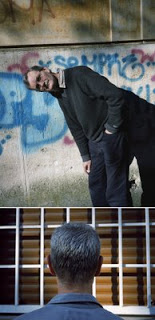John Hurrell – 29 March, 2009
I wondered what would I ask them if I had the chance? Looking at a photograph gives you opportunities to examine somebody in a way you don't have in a face to face situation where you don't want to be intrusive and stare. Do they have secrets that are wickedly strange? Perhaps I would photograph them another way to make them more interesting than Benge's sometimes rather dull effort.
Harvey Benge
I look at you, you look at me
Book of paired photographs
Hardcover, pp 146
FAQ Editions 2008
In this book, one of many Benge has published presenting his photographs, the format is a little different from usual. He has asked the sitters of his portraits to take photographs of him - to go alongside his images of them. A sort of visual conversation.
This approach makes sense. Benge is an affable, gregarious Kiwi who partially lives in Paris and obviously enjoys meeting people. But where they live is important too. Some of his pictures are in New York, but most are in Europe - so part of the fun for the antipodean viewer (if they happen to have travelled widely) is figuring out which cities provide the backdrops. Looking for clues: like snippets of written language on posters, or details of architecture or clothing. Or national facial or body types, if you believe they exist.
How did Benge select these people? Are they friends, strangers, products of a random system? Is there a pattern? Is it facetious to analyse according to class, age, gender, race, sexual orientation, religious beliefs, choice of music, drug of preference?
I guess he could have asked them to photograph anything they like, then and there, on the spot - let them be conceptually creative if they had the inclination. But he insisted they photograph him. Many of the images are boring (by both Benge and guests), but the good ones have a mischievous sense of conspiracy between the two photographers. For example curtains from a nearby window might wrap around both heads, or a sitter might hide their face or show only the back of their head.
I don’t like portraits much as a rule. I find them predictably bland - and I’m a misanthrope anyway - so I was surprised that some of these images made me quite curious about the sitters. Certain qualities made me want to return to these people. Facial expression, exotic background, bodily demeanour, peculiar clothing, an unanticipated prop, an unexpected detail.
I wondered what would I ask them if I had the chance? Looking at a photograph gives you opportunities to examine somebody in a way you don’t have in a face to face situation where you don’t want to be intrusive and stare. Do they have secrets that are wickedly strange? Perhaps I would photograph them another way to make them more interesting than Benge’s sometimes rather dull effort.
What of his process here? Did Benge end up with duds that he thought unpublishable? Did he reject any images? Perhaps even technical cock ups are interesting. With his camera, was it possible for things to go wrong? I wish he had included more bad tempered people. I wish he’d made himself less perky and friendly. Some unguarded, accidental - even disturbing - images would have been great. More truthful than making ‘good’ or ‘normal’ appearances.
With that in mind I find there is one image I really love: of some skinny little guy in a sleeveless jersey standing by an open door. He looks like he’s just fallen out of bed. His eyes are half shut, his hair is a mess and he can barely stay vertical. He seems as if he is patiently indulging Benge, humouring him so he’ll just go away. It’s hilarious and very sweet. A non-photograph that’s a winner.
- John Hurrell

 Two Rooms presents a program of residencies and projects
Two Rooms presents a program of residencies and projects Advertising in this column
Advertising in this column



This Discussion has 0 comments.
Comment
Participate
Register to Participate.
Sign in
Sign in to an existing account.